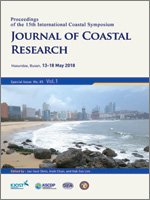Kang, J.J.; Lee, J.H.; Kim, H.C.; Lee, W.C.; Lee, D.; Jo, N.; Min, J.-O., and Lee, S.H., 2018. Monthly variations of phytoplankton community in Geoje-Hansan bay of the southern part of Korea based on HPLC pigment analysis. In: Shim, J.-S.; Chun, I., and Lim, H.S. (eds.), Proceedings from the International Coastal Symposium (ICS) 2018 (Busan, Republic of Korea). Journal of Coastal Research, Special Issue No. 85, pp. 356–360. Coconut Creek (Florida), ISSN 0749-0208.
Seasonal variations in environmental parameters such as temperature, salinity, and nutrients can significantly affect the community structure of phytoplankton, the primary food source of a marine ecosystem. To understand the influences of environmental factors on phytoplankton community structure, phytoplankton pigments analysis were conducted in the Geoje-Hansan bay situated at the southern part of Korea during January to December, 2016 on monthly basis. Salinity in the water was observed to be fairly stable throughout the study period except for the rainy periods during the summer season (August: 30.3 ± 0.3 and September: 31.1 ± 0.2 psu). Water temperature showed typical seasonal patterns similar to the temperate oceans with maximum values during summer seasons (24.9 ± 0.9 °C). Major nutrients (nitrogen, phosphate, and silicate; hereafter N, P, Si) showed similar patterns of seasonal variation with averages of 3.677 ± 2.707μM, 0.338 ± 0.270μM, and 17.614 ± 9.287μM, respectively, with peak values during December. Phytoplankton community composition estimated using the CHEMTAX program showed distinctive seasonal variations during the study period. The results showed a dominance of dinoflagellates during November – March (>64%) with an exception in December whereas diatoms appeared to be dominant during May – October (60.1%). Dinoflagellates exhibited a negative correlation with temperature, whereas diatoms showed a positive correlation with temperature based on principal components analysis (PCA). Given these findings, a diatom-dominant ecosystem would be expected throughout the year under ongoing ocean warming conditions, which could provide different food qualities to upper trophic levels in the Geoje-Hansan bay.





